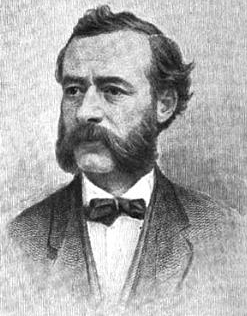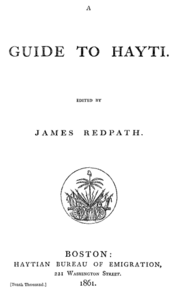James Redpath facts for kids
Quick facts for kids
James Redpath
|
|
|---|---|
 |
|
| Born | August 24, 1833 Berwick upon Tweed, England |
| Died | February 10, 1891 (aged 57) New York, New York |
| Occupation | Journalist, publisher, antislavery activist |
| Subject | Slavery in the United States, John Brown |
| Notable works | The Roving Editor: or, Talks with Slaves in the Southern States (1859) The Public Life of Capt. John Brown (1860) Echoes of Harper's Ferry (1860) |
James Redpath (born August 24, 1833, in Berwick upon Tweed, England; died February 10, 1891, in New York, New York) was an American journalist and a strong activist against slavery. He used his writing and publishing to fight for freedom and equality.
Contents
James Redpath's Story
Early Life and Journalism
James Redpath and his family moved from Scotland to a farm near Kalamazoo, Michigan, around 1848 or 1849. He started working as a printer in Kalamazoo and Detroit. While there, he wrote articles against slavery using the pen name "Berwick."
Later, he became a reporter for the New-York Tribune newspaper. One of his first jobs was to collect "Facts of Slavery." This was a regular series of articles taken from Southern newspapers.
Fighting Slavery
In March 1854, Redpath traveled through the American South. He wanted to see slavery for himself. He talked to enslaved people and gathered information. This research became his book, The Roving Editor: or, Talks with Slaves in the Southern States, published in 1859. He dedicated the book to Captain John Brown, a famous anti-slavery leader.
In 1855, Redpath moved to the Kansas-Missouri border. He reported for a Free Soil newspaper, the Missouri Democrat. This newspaper supported keeping slavery out of new territories. He wrote about the conflict over slavery in Kansas Territory. For three years, he was very involved in Kansas. He worked in politics, wrote news reports, and helped get support for Free Soil settlers from New England.
In 1856, he interviewed John Brown. This was just a few days after a violent event known as the massacre at Pottawatomie Creek. Redpath and Brown shared the same strong views against slavery. Redpath became Brown's biggest supporter and helped spread his message. Besides fighting slavery, Redpath also believed that formerly enslaved people should receive reparations.
Supporting John Brown
Redpath returned east from Kansas in July 1858. During the Pike's Peak Gold Rush in 1859, he wrote a guidebook for gold prospectors. He hoped the book would encourage more Free Soil immigrants to settle in Kansas Territory. This area included parts of what later became Colorado.
In 1858, John Brown asked Redpath to move to Boston. Brown wanted Redpath to help gather support for his plan to start a slave uprising in the South. After John Brown's raid on Harpers Ferry failed in 1859, Redpath wrote the first biography of Brown. This book, The Public Life of Capt. John Brown (1860), was very supportive of Brown. It was announced the day after Brown was executed. The publisher said a "liberal percentage" of the profits would go to Brown's family.
Helping Haiti and Publishing Books
In 1860, Redpath visited Haiti as a reporter. When he returned to the United States, he became Haiti's official representative. He worked to get the U.S. to officially recognize Haiti as a country, which happened within two years. He also directed Haiti's effort to attract free Black people from the United States and Canada to move there. John Brown Jr. worked with him in 1860.
Redpath's book, Guide to Hayti (1860), is a collection of articles about Haiti. He hoped that skilled Black people moving to Haiti would improve conditions there. He also believed it would help end racial prejudice in the United States. After the Civil War, he realized that most Black Americans preferred to stay in their home country.
In 1863 and 1864, Redpath started his own publishing company. He created a series called "Books for the Times." This series included important works like The Black Man by William Wells Brown and Hospital Sketches by Louisa May Alcott. In 1864, he published another series of inexpensive paperbacks called "Books for the Campfires." These books were mainly for Union Army soldiers.
Later that year, he stopped publishing to become a war correspondent. He reported from the armies of George Henry Thomas and William Tecumseh Sherman in Georgia and South Carolina. In February 1865, military leaders appointed him the first superintendent of public schools in the Charleston, South Carolina, area. He quickly had over 100 teachers working with 3,500 African-American and white students. He also started an orphanage.
Memorial Day and Later Life
In May 1865, in Charleston, Redpath organized a service to honor Union Army soldiers who had died there. Some people consider this to be the first-ever Memorial Day service. However, others say it was more like a cemetery dedication, similar to the one in Gettysburg, Pennsylvania, in 1863.
Redpath's strong anti-slavery views and his efforts to integrate schools worried military officials. They replaced him because he was seen as a problem by President Andrew Johnson.
In 1868, Redpath started one of the first professional speaking agencies in the country. It was called the Boston Lyceum Bureau, and later became known as the Redpath Bureau. This agency provided speakers and performers for lyceums (public lecture halls) across the country. It represented famous people like Mark Twain, Julia Ward Howe, Frederick Douglass, and Susan B. Anthony. The Redpath Bureau became the most successful agency of its kind.
Redpath sold his share in the Bureau in 1875. He then lived in Washington, D.C., and New York, when he wasn't traveling. In the late 1870s, his health declined. However, in 1880–81, he reported on a famine and land conflicts in western Ireland. Redpath was deeply moved by the extreme poverty he saw in rural Ireland. He convinced his friend, fellow anti-slavery activist David Ross Locke, to support Irish nationalism.
Redpath became a strong supporter of the Land League and Charles Stewart Parnell, who fought for Irish farmers' rights. When he returned to the United States, he gave lectures, wrote newspaper articles, and published Talks about Ireland and Redpath's Weekly. Both were dedicated to Irish causes.
Redpath became the editor of the North American Review in 1886. He died in 1891 after being hit by a horse-drawn trolley in New York.
Works


